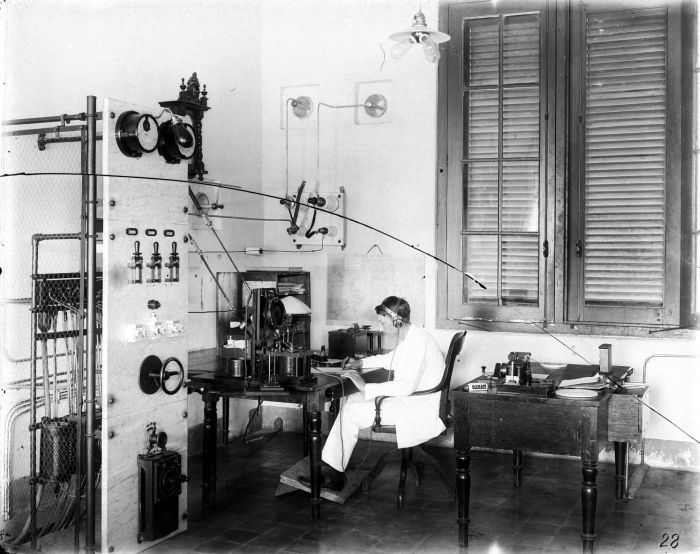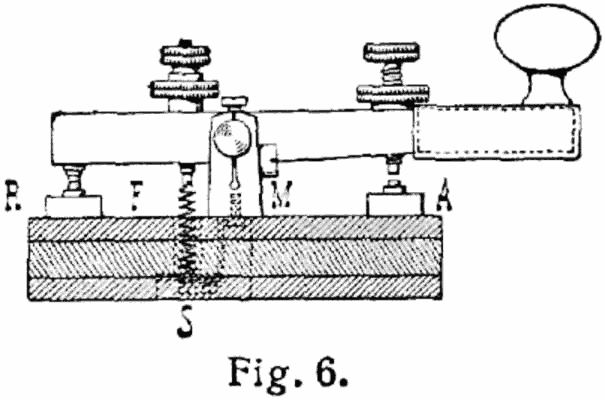|
Morse Key
A telegraph key is a specialized electrical switch used by a trained operator to transmit text messages in Morse code in a telegraphy system. Keys are used in all forms of electrical telegraph systems, including landline (also called wire) telegraphy and radio (also called wireless) telegraphy. An operator uses the telegraph key to send electrical pulses (or in the case of modern CW, unmodulated radio waves) of two different lengths: short pulses, called ''dots'' or ''dits'', and longer pulses, called ''dashes'' or ''dahs''. These pulses encode the letters and other characters that spell out the message. Types Since its original inception, the telegraph key's design has developed such that there are now multiple types of keys. Straight keys A ''straight key'' is the common telegraph key as seen in various movies. It is a simple bar with a knob on top and an electrical contact underneath. When the bar is pressed down against spring tension, it makes a closed electric cir ... [...More Info...] [...Related Items...] OR: [Wikipedia] [Google] [Baidu] |
Electronic Switch
In electronics, an electronic switch is an electronic component or device that can switch an electrical circuit, interrupting the current or diverting it from one conductor to another. Electronic switches are considered binary devices because they can be on or off. When an electronic switch is ''on'', the circuit is closed and when it is ''off'', the switch is open in the circuit. Typically, electronic switches use solid state devices such as transistors, though vacuum tubes can be used as well in high voltage applications. Electronic switches also consist of complex configurations that are assisted by physical contact. Physical contact typically comes from pressing or flipping a switch mechanically, but other forms of contact, such as light sensors and magnetic field sensors, are used to operate switches. Types Depending on application, switches are manufactured in many types. Switches operated by a person are called ''hand switches''. Hand switches consist of many types such ... [...More Info...] [...Related Items...] OR: [Wikipedia] [Google] [Baidu] |
Iamb (poetry)
An iamb () or iambus is a metrical foot used in various types of poetry. Originally the term referred to one of the feet of the quantitative meter of classical Greek prosody: a short syllable followed by a long syllable (as in () "beautiful (f.)"). This terminology was adopted in the description of accentual-syllabic verse in English, where it refers to a foot comprising an unstressed syllable followed by a stressed syllable (as in ''abóve''). Thus a Latin word like , because of its short-long rhythm, is considered by Latin scholars to be an iamb, but because it has a stress on the first syllable, in modern linguistics it is considered to be a trochee. Etymology R. S. P. Beekes has suggested that the grc, ἴαμβος ''iambos'' has a Pre-Greek origin. An old hypothesis is that the word is borrowed from Phrygian or Pelasgian, and literally means "Einschritt", i. e., "one-step", compare ''dithyramb'' and ''thriambus'', but H. S. Versnel rejects this etymology and sugg ... [...More Info...] [...Related Items...] OR: [Wikipedia] [Google] [Baidu] |
Words Per Minute
Words per minute, commonly abbreviated wpm (sometimes uppercased WPM), is a measure of words processed in a minute, often used as a measurement of the speed of typing, reading or Morse code sending and receiving. Alphanumeric entry Since words vary in length, for the purpose of measurement of text entry the definition of each "word" is often standardized to be five characters or keystrokes long in English, including spaces and punctuation. For example, under such a method applied to plain English text the phrase "I run" counts as one word, but "rhinoceros" and "let's talk" would both count as two. Karat et al. found in one study of average computer users in 1999 that the average rate for transcription was 32.5 words per minute, and 19.0 words per minute for composition. In the same study, when the group was divided into "fast", "moderate", and "slow" groups, the average speeds were 40 wpm, 35 wpm, and 23 wpm, respectively. With the onset of the era of desktop computers, fast ty ... [...More Info...] [...Related Items...] OR: [Wikipedia] [Google] [Baidu] |
Telegraphist
A telegraphist (British English), telegrapher (American English), or telegraph operator is an operator who uses a telegraph key to send and receive the Morse code in order to communicate by land lines or radio. During the Great War the Royal Navy enlisted many volunteers as radio telegraphists. Telegraphists were indispensable at sea in the early days of wireless telegraphy, and many young men were called to sea as professional radiotelegraph operators who were always accorded high-paying officer status at sea. Subsequent to the ''Titanic'' disaster and the Radio Act of 1912, the International Safety of Life at Sea ( SOLAS) conventions established the 500kHz maritime distress frequency monitoring and mandated that all passenger-carrying ships carry licensed radio telegraph operators. In popular culture *The telegraphist mouse in Australia and the Marshall Islands from ''The Rescuers Down Under''. See also * Amateur radio * Casa del Telegrafista (House of the Telegraphe ... [...More Info...] [...Related Items...] OR: [Wikipedia] [Google] [Baidu] |
QSK Operation (full Break-in)
In CW Morse code operations, QSK or full break-in operation describes an operating mode in which the transmitting station can detect signals from other stations between the elements (dots and dashes) or letters of the Morse transmission. This allows other stations to interrupt the transmitting station between individual coding elements, and such allows for a conversational style of communication. "QSK" is one of the Q-code signals established for radiotelegraph operators in the first decade of the 1900s. The three letter code "QSK" literally means "''I can hear you between my signals; you may break in on my transmission.''" Although Morse code is no longer used for commercial or professional purposes, it continues to be used in amateur radio. In ''QSK'' or ''full break-in'' operation the silent periods between the Morse code dits and dahs enable operators to listen between their transmitted signals for the signals of the counterpart, thus enabling a conversational style of com ... [...More Info...] [...Related Items...] OR: [Wikipedia] [Google] [Baidu] |
Prosigns For Morse Code
Procedural signs or prosigns are shorthand signals used in Morse code radio telegraphy procedure, for the purpose of simplifying and standardizing radio communication protocol. They are separate from Morse code abbreviations, which consist mainly of brevity codes that convey messages to other parties with greater speed and accuracy. In general prosigns are just standardised parts of short form radio protocol, and can include any abbreviation. An example would be K for "okay, heard you, continue". In a more limited role the term refers to something akin to that of the nonprinting control characters in teleprinter and computer character sets, such as Baudot or ASCII. Different from abbreviations, those are universally recognizable across language barriers as distinct and well-defined symbols. At the coding level, prosigns admit any form the Morse code can take, unlike abbreviations which have to follow letter form. Many of them are longer than typical characters and are rendered wi ... [...More Info...] [...Related Items...] OR: [Wikipedia] [Google] [Baidu] |
Traffic Analysis
Traffic analysis is the process of intercepting and examining messages in order to deduce information from patterns in communication, it can be performed even when the messages are encrypted. In general, the greater the number of messages observed, the greater information be inferred. Traffic analysis can be performed in the context of military intelligence, counter-intelligence, or pattern-of-life analysis, and is also a concern in computer security. Traffic analysis tasks may be supported by dedicated computer software programs. Advanced traffic analysis techniques which may include various forms of social network analysis. Traffic analysis has historically been a vital technique in cryptanalysis, especially when the attempted crack depends on successfully seeding a known-plaintext attack, which often requires an inspired guess based on how specific the operational context might likely influence what an adversary communicates, which may be sufficient to establish a short crib. ... [...More Info...] [...Related Items...] OR: [Wikipedia] [Google] [Baidu] |

